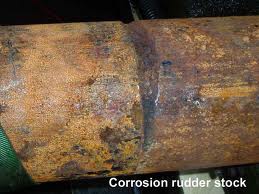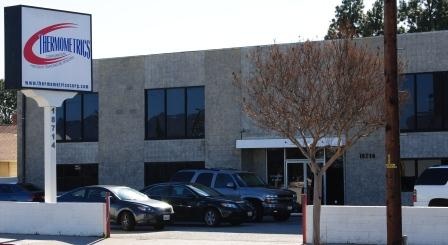In most cases the naked eye is sufficient, but sometimes magnification is helpful or required. Valuable information for the solution of a corrosion problem can often be obtained through careful observation of the corroded test specimens or failed equipment. There are eight forms of metal corrosion. The eight forms are: (1) uniform or general attack, (2) galvanic or two metal corrosion, (3) crevice corrosion, (4) pitting, (5) intergranular corrosion, (6) selective leaching, (7) erosion corrosion, (8) stress corrosion.
Uniform Attack- Uniform attack is the most common form of corrosion. It is normally characterized by a chemical or electrochemical reaction which proceeds uniformly over the entire exposed surface or over a large area. The metal becomes thinner and eventually fails. Uniform attack, or general overall corrosion represents the greatest destruction of metal on a tonnage basis. Uniform attack can be prevented or reduced by (1) proper materials, (2) inhibitors, (3) cathodic protection.
Galvanic or Two Metal Corrosion- A potential difference usually exists between two dissimilar metals when they are immersed in a corrosive or conductive solution. If these metals are placed in contact, this potential difference produces electron flow between them. Corrosion of the less corrosion-resistant metal is usually increased and attack of the more resistant material is decreased, as compared with the behavior of these metals when they are not in contact. The less resistant metal becomes Anodic and the more resistant metal cathodic. Usually the cathode or cathodic metal corrodes very little or not at all in this type of couple. Because of the electric currents and dissimilar metals involved, this form of corrosion is called galvanic, or two metal corrosion.
Crevice Corrosion- Intense localized corrosion frequently occurs within crevices and other shielded areas on metal surfaces exposed to corrosives. This type of attack is usually associated with small volumes of stagnant solution caused by holes, gasket surfaces, lap joints, surface deposits, and crevices under bolt and rivet heads.
Pitting- Pitting is a form of extremely localized attack that results in holes in the metal. These holes may be small or large in diameter, but in most cases they are relatively small. Generally a pit may be described as a cavity or hole with the surface diameter about the same as or less than the depth. Pitting is one of the most destructive and insidious forms of corrosion. It is often difficult to detect pits because of their small size and because the pits are often covered with corrosion products. Pitting is particularly vicious because it is a localized and intense form of corrosion, and failures often occur with extreme suddenness.
Intergranular Corrosion- Grain boundary effects are of little or no consequence in most applications or uses of metals. Intergranular corrosion can be caused by impurities at the grain boundaries, enrichment of one of the alloying elements, or depletion of one of the elements in the grain-boundary areas.
Selective Leaching- Selective leaching is the removal of one element from a solid alloy by corrosion processes. The most common example is the selective removal of zine in brass alloys. Parting is a metallurgical term that is sometimes applied, but selective leaching is preferred.
Erosion Corrosion- Erosion corrosion is the acceleration or increase in rate of deterioration or attack on metal because of relative movement between a corrosive fluid and the metal surface. Metal is removed from the surface as dissolved ions, or it forms solid corrosion products which are mechanically swept from the metal surface. Erosion is characterized in appearance by grooves, gullies, waves, rounded holes, and valleys and usually exhibits a directional pattern.
Stress Corrosion Cracking- Stress corrosion cracking refers to cracking caused by the simultaneous presence of tensile stress and a specific corrosive medium. Many investigators have classified all cracking failures occurring in corrosive mediums as stress-corrosion cracking. During stress corrosion cracking, the metal or alloy is virtually unattacked over most of its surface, while fine cracks progress through it. This cracking phenomenon has serious consequences since it can occur at stresses within the range of typical design stress. The two classic cases of stress-corrosion cracking are "season cracking" of brass and the "caustic embrittlement" of steel. Season cracking refers to the stress-corrosion cracking failure of brass cartridge cases. During periods of heavy rainfall, especially in the tropics, cracks were observed in the brass cartridge cases at the point where the case was crimped to the bullet.


At Thermometrics, our guiding objectives are Customer Satisfaction and Continuous Improvement. We accomplish this through monitoring our systems, measuring our performance and employee development. Our goal is to continually work at being the most successful company in the world, in delivering the highest quality of products, technology, competitive pricing, continuous customer service and satisfaction.